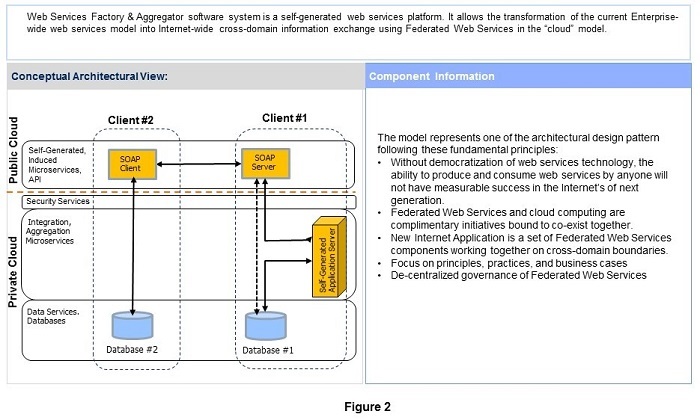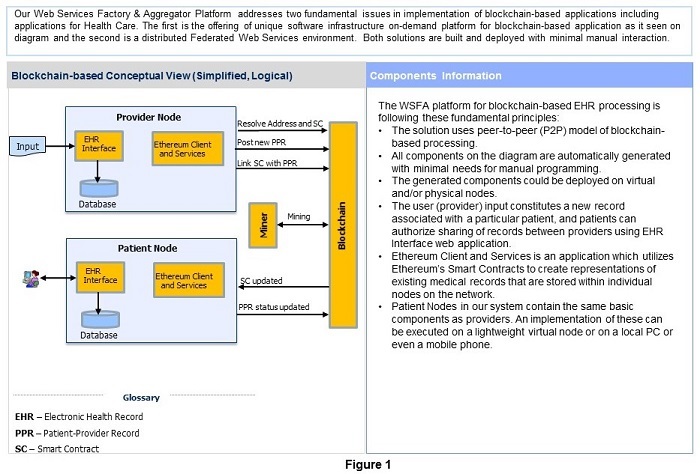WS Factory and Aggregator: Web Services Factory and Aggregator (WSFA)
by Peter Kinev
Web Services Factory and Aggregator (WSFA) is a self-generated software platform based on the original ideas of the Semantic Web - an extension of the Web through common framework.
Austin, United States Interoperability Blockchain Patient and Provider Tools Real Time Results challenge NOLAHI Challenge - See AllAbout our project

The problem we solve: The unique value proposition of our WSFA is to provide the means for any small to medium enterprise, an individual or collective of users to effectively, and economically develop and deploy their custom Web Services, APIs, and Web clients. Our solution is to extend the basic "cloud" with the ability to provide services across separate and independent domains. It was made possible by our Web Services Factory and Aggregator (WSFA) Platform. The WSFA Platform has universal applicability but is particularly suitable for blockchain-based applications.

About our solution: The most important fact about our WSFA platform is a true elimination of all programming requirements for the end-user. It includes automatic code generation and deployment as a SaaS applications in the "cloud." The WSFA applies source-code generation technique of semantic web processing to build a complete application with Web Services on distributed worker nodes using data models and ontological models according to relatively simple rules. The abovementioned unique capability of WSAF Platform is particularly suitable for implementation of blockchain-based applications. Block chain technology rests on three founding principles. First, data is stored in a public, immutable transaction ledger with complete and ir refutable record of all transactions. Second, blockchains are implemented in a decentralized network of computing nodes. Third, the metad ata describing each transaction is available to everyone on the system, but in encrypted form.

Progress to date:
The system was demonstrated at a few technical venues. The demonstrations received very positive responses. The functionality of the WSFA Platform adds a flexible solution for integration and concurrent operation of new and existing databases - an environment for creation and operation of cloud applications and services.
About Our Team

Creator: Peter Kinev
Location: Texas
Bio: Highly accomplished Enterprise Architect with formal knowledge of architectural frameworks and methods for developing enterprise architecture, such as Zachman Framework and TOGAF, with knowledge of Semantic Web technologies and ontologies. All together he brings about 20 years of practical experience in Intranet/Extranet Enterprise Architecture with more than 25 years of experience in Systems Engineering and Architecture. He has an experience with many programming languages and environments, formal SDLC and contemporary development methodologies. He is also a Certified J2EE Architect. The list of the most recent projects contains the work done during last few years.
Title: Enterprise SOA Architect
About Our Company
Open Solutions
Location: 3402 Exposition Blvd
Austin 78703
US
Founded: 17
Website: http://opensolution-us.com
Other link: http://opensolution-us.com/aggservices/images/OpenSolutions.pdf
Product Stage: Prototype/MVP
Employees: 3-5
How We Help Patients
Available in Emergency: If you are in an accident and are unable to explain your health history to a health care provider, they can find the information about your medications, health issues, and tests and make informed decisions about your emergency care faster. Protected in Disasters: If you are in an area affected by a disaster, like Hurricane Katrina, your health information can be stored safely in electronic form. Improved Care/Reduced Medical Errors: Access to information about care you receive elsewhere gives your health care provider a better, more complete picture of your health. That means your health care provider can make sure the care he or she provides doesn't interact badly with other treatment you may be receiving.How We Help Physicians
• Enhanced care coordination through communication between providers is of critical importance for patient care, and leads to improved outcomes and patient safety. It can also reduce or eliminate redundant and unnecessary testing. • Access to the right information, at the right time, for providers, patients and all other stakeholders. • Improved efficiency and reliability through the elimination of unnecessary paperwork and providing caregivers with clinical decision support tools. • Improved quality and safety through reduction of medication and medical errors.How We Help Hospitals
Care coordination - This is a dynamic process that requires data movement across platforms and among service providers in real time. Many EHR systems, in spite of being developed by the same company, do not talk to each other, creating delays and decreasing the value of the system. • Record Locator Services / Master Patient Indexes - Enable creation of one continuous community record, facilitating patient identification across multiple provider settings. • Data exchange - HIEs/HIOs provide support for vocabulary and code sets including content mapping, and enable data transactions to occur automatically across multiple providers and settings. • Data aggregation and analysis - This includes clinical data aggregation across HIE partners, as well as data analytics and warehousing. • Performance outcome management - Population-level data analysis is an essential component of pay-for-performance programs, ACOs, public health systems and other stakeholders. • Business intelligence analytics - Enable better risk analysis and better, more cost-effective care of high-risk patients. • Clinical messaging - Standard HIE services often include laboratory results, emergency room notes, medication lists, discharge summaries, progress notes, radiology results and surgical notes. • Support for EHR, PHR and MU adoption consultation.How We Help Partners
The solution is a platform engineered to leverage both Blockchain technologies and Fast Healthcare Interoperability Resources (FHIR) compliant APIs to increase efficiencies, enable near real-time claim adjudication, transparent agreements between stakeholders and decreased fraud. FHIR was created as an industry standard to format data thereby reducing integration complexity. A key aspect of the solution, due to the cost of adding data to the blockchain, is limiting that data to only what is needed for the smart contracts to execute. The proposed solution has two main goals: (1) enable the provider and patient to have a conversation around out of pocket cost, and (2) drastically reduce the billing- and insurance-related administrative costs.Challenge Mission
How We Address the Mission of The Challenge(s)
Open Solution's WSFA Platform contributes to the part of Web 3.0 associated with intelligent web - semantic web, reduction of humans' tasks and decision tasks. The new computing environment allows human-machine and machine-to-machine co-operations and organizing a large number of web communities. Our solution is engineered to provide the infrastructure foundation for implementation of distributed ledger technology (DLT) applications including Blockchain and non-Blockchain based. Currently we evaluate two separate approaches – blockchain-based and hashgraph-based. Our in house developed Web Services and Aggregation Platform (WSFA) facilitates a creation and deployment of computing nodes and interfaces in peer-to-peer communication to increase efficiencies, and to enable Electronic Health Records (EHR) processing that involve security (specifically data integrity) and privacy provisioning, immutably assuring expressed identities, creating highly robust audit trails and improving healthcNew Orleans and Our Company
The Louisiana Department of Health and Hospitals (DHH) published today (01/28/2018) a Request for Information with the intent to explore and determine interested and qualified vendors who offer an electronic health records solution that could be utilized in the parish health units. (http://ldh.la.gov/index.cfm/newsroom/detail/5033 ) We are absolutely positioned to take this challenge! That's OUR MISSION.Innovation Details
Intellectual Property Summary
Our solution is a platform engineered to leverage both Blockchain/Distributed Ledger technologies and Fast Healthcare Interoperability Resources (FHIR) compliant APIs to increase efficiencies, enable near real-time claim adjudication, transparent agreements between stakeholders and decreased fraud. FHIR was created as an industry standard to format data thereby reducing integration complexity. A key aspect of the solution, due to the cost of adding data to the blockchain, is limiting that data to only what is needed for the smart contracts to execute.
Clinical Information
The Office of the National Coordinator for Health Information Technology issued a Shared Nationwide Interoperability Roadmap, which defines critical Policy and Technical Components needed for nationwide interoperability, including (1) Ubiquitous, Secure Network Infrastructure, (2) Verifiable Identity and Authentication of All Participants, (3) Consistent Representation of Authorization to Access Electronic Health Information, and several other requirements. However, current technologies do not fully address these requirements, because they face limitations related to security, privacy, and full ecosystem interoperability.
To date, there is no full-volume rollout of a blockchain for healthcare, and the scenario presented above represents a hypothetical with a number of contingencies.
Regulatory Status
Not Aplicable
How we will use the funds raised
We need funds to complete development of our system. The estimated time and efort will be close to 6 months.
Thank You
The recommended solution is a platform engineered to leverage both Blockchain technologies and Web Services and Aggregation Platform (WSFA) which facilitates a creation and deployment of interfaces in peer-to-peer communication to increase efficiencies, enable near real-tim e claim adjudication, transparent agreements between stakeholders and decreased fraud.
We would build a decentralised Internet network where all of us would access documents and content without going through a server. It means that you will need zero infrastructure to develop and distribute applications.
Updates
-
Update #1
EHR & HIE
Our solution is engineered to provide the infrastructure foundation for implementation of distributed ledger technology (DLT) applications including Blockchain and non-Blockchain based. Currently we evaluate two separate approaches – blockchain-based and hashgraph-based. Our in house developed Web Services and Aggregation Platform (WSFA) facilitates a creation and deployment of computing nodes and interfaces in peer-to-peer communication to increase efficiencies, and to enable Electronic Health Records (EHR) processing that involve security (specifically data integrity) and privacy provisioning, immutably assuring expressed identities, creating highly robust audit trails and improving healthcare-related security for both providers and patients. We also believe that our product naturally aligns with the ideas of Health Information Exchange (HIE). The paper on our website provides detail information on EHR processing with application of our WSFA platform. In this context, Open Solution's WSFA Platform contributes to the part of Web 3.0 associated with intelligent web - semantic web, reduction of humans' tasks and decision tasks. The new computing environment allows human-machine and machine-to-machine co-operations and organizing a large number of web communities.
Supporters
-
09/19/2019 - Followed the project., M.Tech, B.Tech
06/19/2019 - Followed the project., M.Tech, B.Tech
06/19/2019 - Interested in a partnership with the project. Instant Feedback
Instant Feedback
Help us find best new ideas to fund by telling us what you think. Your feedback goes straight to the team behind this project in private, so tell them what you really think.
63Medstartr
Index Score38
Interest
Score5
Adoption
Score3
Likes1
Partners0
Pilots2
Follows-
This campaign has ended but you can still get involved.See options below.
$100 pledged of $200,001 goal
Instant Feedback
Help us find best new ideas to fund by telling us what you think. Your feedback goes straight to the team behind this project in private, so tell them what you really think.




